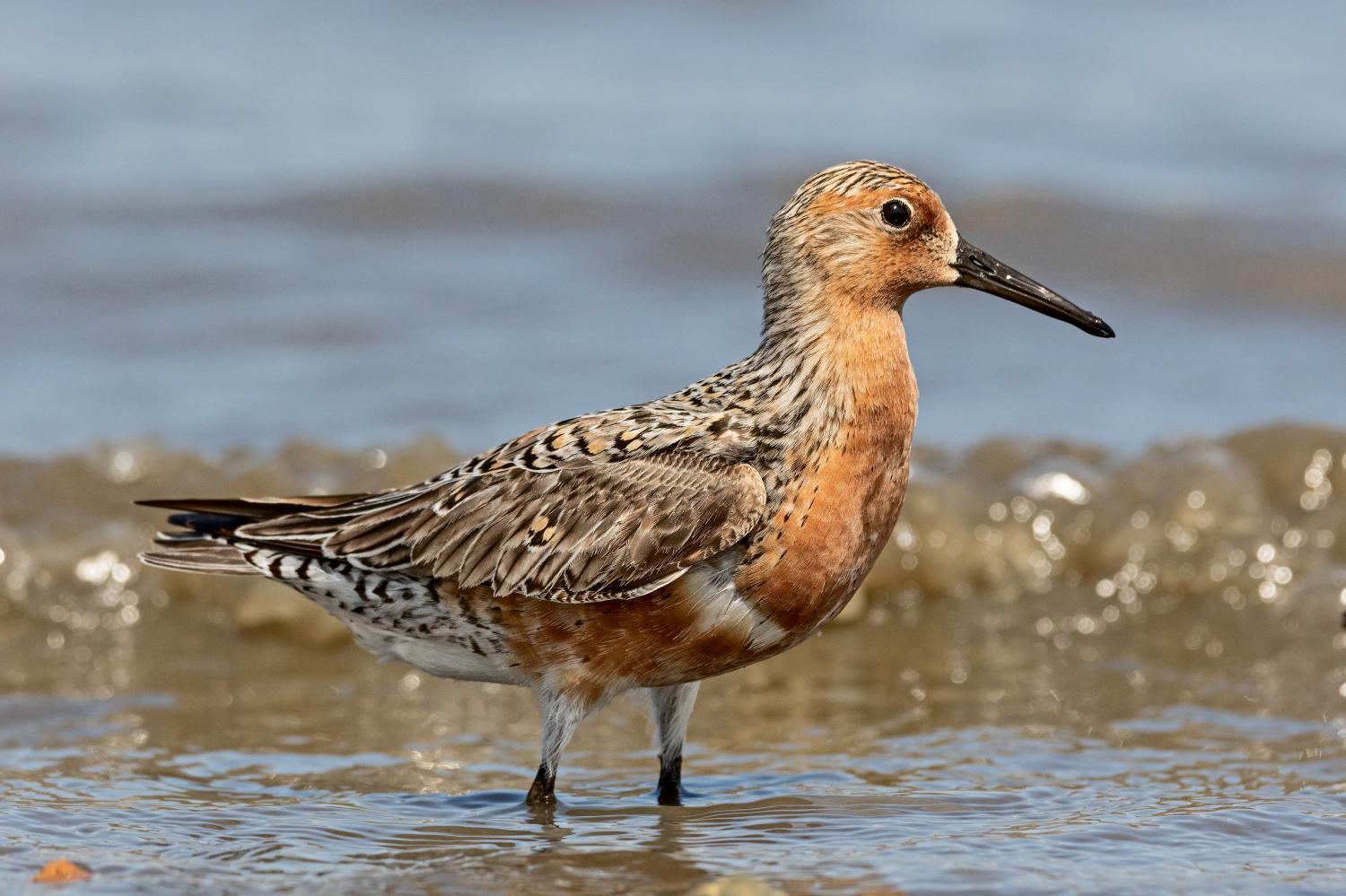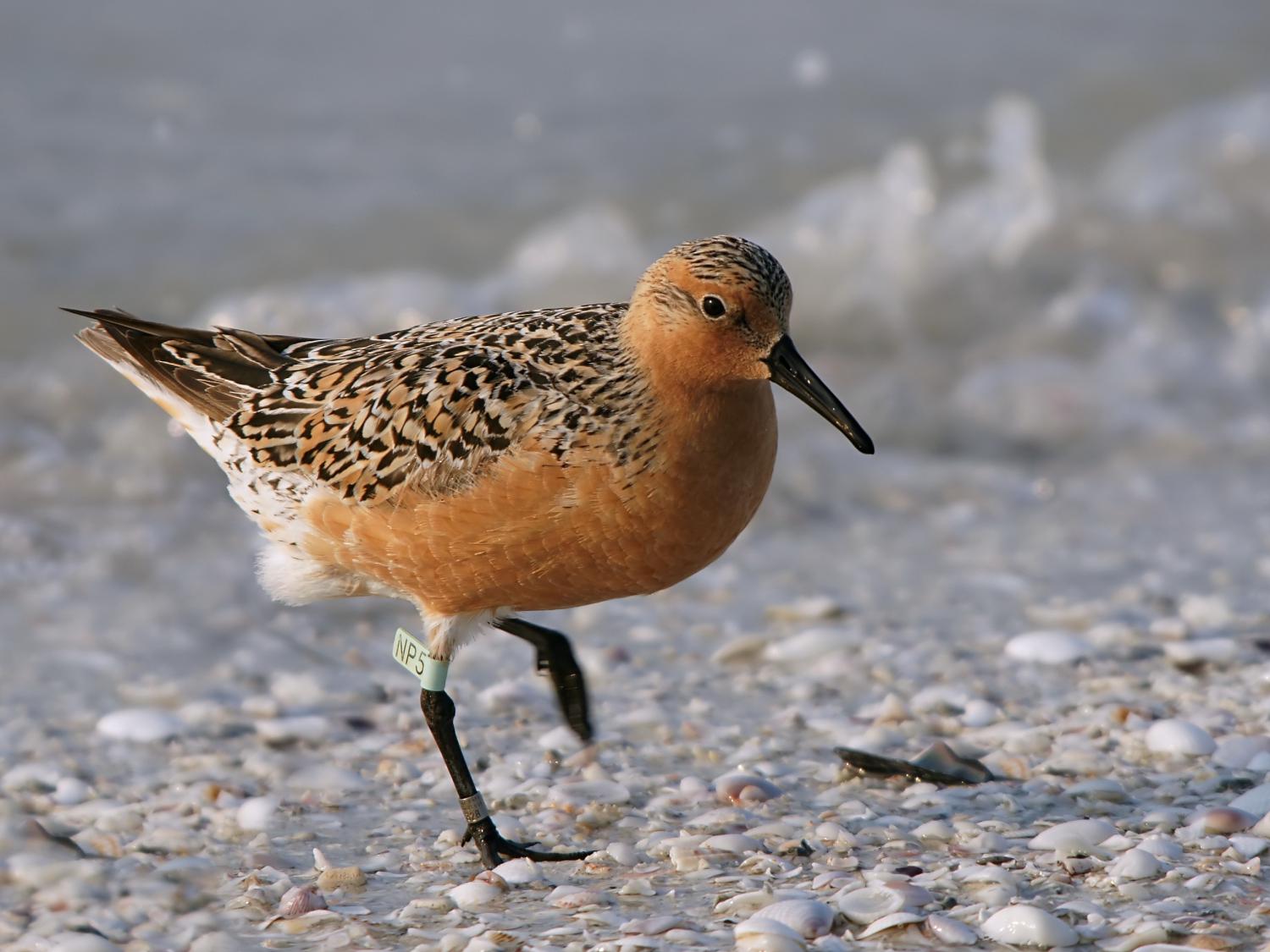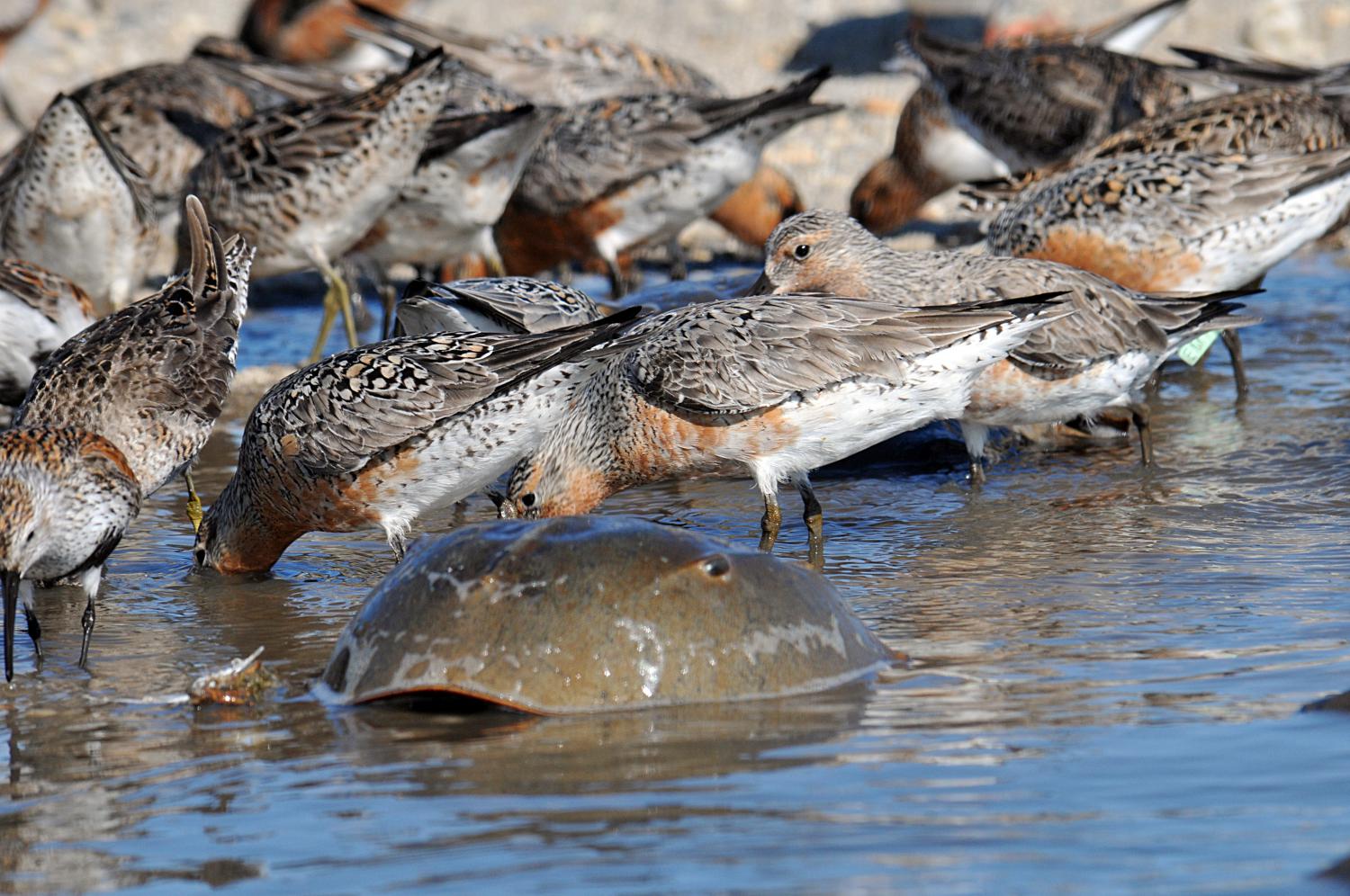Species of Thailand
Red knot
Calidris canutus
Carolus Linnaeus, 1758
In Thai: นกน็อตเล็ก
The red knot (Calidris canutus) (just knot in English-speaking Europe) is a medium-sized shorebird which breeds in tundra and the Arctic Cordillera in the far north of Canada, Europe, and Russia. It is a large member of the Calidris sandpipers, second only to the great knot. Six subspecies are recognised.
Their diet varies according to season; arthropods and larvae are the preferred food items at the breeding grounds, while various hard-shelled molluscs are consumed at other feeding sites at other times. North American breeders migrate to coastal areas in Europe and South America, while the Eurasian populations winter in Africa, Papua New Guinea, Australia, and New Zealand. This species forms enormous flocks when not breeding.
Taxonomy, systematics, and evolution
The red knot was first described by Carl Linnaeus in his landmark 1758 10th edition of Systema Naturae as Tringa canutus. One theory is that it gets its name and species epithet from King Cnut; the name would refer to the knot's foraging along the tide line and the story of Cnut and the tide. There appears to be no historical foundation for this etymology. Another etymology is that the name is onomatopoeic, based on the bird's grunting call note.
The red knot and the great knot were originally the only two species placed in the genus Calidris, but many other species of sandpiper were subsequently added. A 2004 study found that the genus was polyphyletic and that the closest relative of the two knot species is the surfbird (currently Aphriza virgata).
There are six subspecies, in order of size;
- C. c. roselaari (Tomkovich, 1990) – (largest)
- C. c. rufa (Wilson, 1813)
- C. c. canutus (Linnaeus, 1758)
- C. c. islandica (Linnaeus, 1767)
- C. c. rogersi (Mathews, 1913)
- C. c. piersmai (Tomkovich, 2001) – (smallest)
Studies based on mitochondrial sequence divergence and models of paleoclimatic changes during the glacial cycles suggest that canutus is the most basal population, separating about 20, 000 years ago (95% confidence interval: 60, 000–4, 000 years ago) with two distinct lineages of the American and Siberian breeders emerging about 12, 000 years ago (with a 95% confidence interval: 45, 000–3, 500 years ago).
Distribution and migration
In the breeding season, the red knot has a distribution in the high Arctic, then migrates to coasts around the world from 50° N to 58° S. The red knot has one of the longest migrations of any bird. Every year it travels more than 9000 km from the Arctic to the southern tip of South America. The exact migration routes and wintering grounds of individual subspecies are still somewhat uncertain. The nominate race C. c. canutus breeds in the Taymyr Peninsula and possibly Yakutia and migrates to Western Europe and then down to western and southern Africa. C. c. rogersi breeds in the Chukchi Peninsula in eastern Siberia, and winters in eastern Australia and New Zealand. Small and declining numbers of rogersi (but possibly of the later described piersmai) winter in the mudflats in the Gulf of Mannar and on the eastern coast of India. The recently split race C. c. piersmai breeds in the New Siberian Islands and winters in north-western Australia. C. c. roselaari breeds in Wrangel Island in Siberia and north-western Alaska, and it apparently winters in Florida, Panama and Venezuela. C. c. rufa breeds in the Canadian low Arctic, and winters South America, and C. c. islandica breeds in the Canadian high Arctic as well as Greenland, and winters in Western Europe.
Birds wintering in west Africa were found to restrict their daily foraging to a range of just 2 – 16 km2 of intertidal area and roosted a single site for several months. In temperate regions such as the Wadden Sea they have been found to change roost sites each week and their feeding range may be as much as 800 km2 during the course of a week.
B95, also known as Moonbird, is a noted individual of the subspecies C. c. rufa. A male, he has become famous amongst conservationists for his extreme longevity — he was aged at least 20 as of his last sighting in May 2014.
Description and anatomy
An adult red knot is the second largest Calidris sandpiper, measuring 23 – 26 cm long with a 47 – 53 cm wingspan. The body shape is typical for the genus, with a small head and eyes, a short neck and a slightly tapering bill that is no longer than its head. It has short dark legs and a medium thin dark bill. The winter, or basic, plumage becomes uniformly pale grey, and is similar between the sexes. The alternate, or breeding, plumage is mottled grey on top with a cinnamon face, throat and breast and light-coloured rear belly. The alternate plumage of females is similar to that of the male except it is slightly lighter and the eye-line is less distinct. Canutus, islandica and piersmai are the "darker" subspecies. Subspecies rogersi has a lighter belly than either roselaari or piersmai, and rufa is the lightest in overall plumage. The transition from alternate to basic plumages begins at the breeding site but is most pronounced during the southwards migration. The molt to alternate plumage begins just prior to the northwards migration to the breeding grounds, but is mostly during the migration period.
The large size, white wing bar and grey rump and tail make it easy to identify in flight. When feeding the short dark green legs give it a characteristic 'low-slung' appearance. When foraging singly, they rarely call, but when flying in a flock they make a low monosyllabic and when migrating they utter a disyllabic . They breed in the moist tundra during June to August. The display song of the male is a fluty poor-me. The display includes circling high with quivering wing beats and tumbling to the ground with the wings held upward. Both sexes incubate the eggs, but the female leaves parental care to the male once the eggs have hatched.
Juvenile birds have distinctive submarginal lines and brown coverts during the first year. In the breeding season the males can be separated with difficulty (<80% accuracy in comparison to molecular methods) based on the more even shade of the red underparts that extend towards the rear of the belly.
The weight varies with subspecies, but ranges between 100 and 200 g. Red knots can double their weight prior to migration. Like many migratory birds they also reduce the size of their digestive organs prior to migration. The extent of the atrophy is not as pronounced as species like the bar-tailed godwit, probably because there are more opportunities to feed during migration for the red knot. Red knots are also able to change the size of their digestive organs seasonally. The size of the gizzard increases in thickness when feeding on harder foods on the wintering ground and decreases in size while feeding on softer foods in the breeding grounds. These changes can be very rapid, occurring in as little as six days.
Diet and feeding
On the breeding grounds, knots eat mostly spiders, arthropods, and larvae obtained by surface pecking, and on the wintering and migratory grounds they eat a variety of hard-shelled prey such as bivalves, gastropods and small crabs that are ingested whole and crushed by a muscular stomach.
While feeding in mudflats during the winter and migration red knots are tactile feeders, probing for unseen prey in the mud. Their feeding techniques include the use of shallow probes into the mud while pacing along the shore. When the tide is ebbing, they tend to peck at the surface and in soft mud they may probe and plough forward with the bill inserted to about 1 cm in depth. The bivalved mollusc Macoma is their preferred prey on European coasts, swallowing them whole and breaking them up in their gizzard. In Delaware Bay, they feed in large numbers on the eggs of horseshoe crabs, a rich, easily digestible food source, which spawn just as the birds arrive in spring. They are able to detect molluscs buried under wet sand from changes in the pressure of water that they sense using Herbst corpuscles in their bill. Unlike many tactile feeders their visual field is not panoramic (allowing for an almost 360 degree field of view), as during the short breeding season they switch to being visual hunters of mobile, unconcealed prey, which are obtained by pecking. Pecking is also used to obtain some surface foods in the wintering and migratory feeding grounds, such as the eggs of horseshoe crabs.
Breeding
The red knot is territorial and seasonally monogamous; it is unknown if pairs remain together from season to season. Males and females breeding in Russia have been shown to exhibit site fidelity towards their breeding locales from year to year, but there is no evidence as to whether they exhibit territorial fidelity. Males arrive before females after migration and begin defending territories. As soon as males arrive, they begin displaying, and aggressively defending their territory from other males.
The red knot nests on the ground, near water, and usually inland. The nest is a shallow scrape lined with leaves, lichens and moss. Males construct three to five nest scrapes in their territories prior to the arrival of the females. The female lays three or more usually four eggs, apparently laid over the course of six days. The eggs measure 43 x 30 mm in size and are ground coloured, light olive to deep olive buff, with a slight gloss. Both parents incubate the eggs, sharing the duties equally. The off duty parent forages in flocks with others of the same species. The incubation period lasting around 22 days. At early stages of incubation the adults are easily flushed from the nest by the presence of humans near the nest, and may not return for several hours after being flushed. However, in later stages of incubation they will stay fast on the eggs. Hatching of the clutch is usually synchronised. The chicks are precocial at hatching, covered in downy cryptic feathers. The chicks and the parents move away from the nest within a day of hatching and begin foraging with their parents. The female leaves before the young fledge while the males stay on. After the young have fledged, the male begins his migration south and the young make their first migration on their own.
Status
The red knot has an extensive range, estimated at 100000 – 1000000 km2, and a large population of about 1.1 million individuals. The species is not believed to approach the thresholds for the population decline criterion of the IUCN Red List (i.e., declining more than 30% in ten years or three generations), and is therefore evaluated as least concern. However many local declines have been noted such as the dredging of intertidal flats for edible cockles (Cerastoderma edule) which led to reductions in the wintering of islandica in the Dutch Wadden Sea. The quality of food at migratory stopover sites is a critical factor in their migration strategy.
This is one of the species to which the Agreement on the Conservation of African-Eurasian Migratory Waterbirds (AEWA) applies. This commits signatories to regulate the taking of listed species or their eggs, to establish protected areas to conserve habitats for the listed species, to regulate hunting and to monitor the populations of the birds concerned.
Threats to the subspecies rufa
Towards the end of the 19th century, large numbers of red knot were hunted commercially for sport and food as they migrated through North America. It is hypothesized that more recently, the birds have become threatened as a result of commercial harvesting of horseshoe crabs in the Delaware Bay which began in the early 1990s. Delaware Bay is a critical stopover point during spring migration, supporting an estimated 50 to 80 percent of all migrating rufa red knots each year; the birds refuel by eating the eggs laid by these crabs (with little else to eat in the Delaware Bay). If horseshoe crab abundance in the Bay is reduced there may be fewer eggs to feed on which could negatively affect knot survival.
In 2003, scientists projected that at its current rate of decline the American subspecies, rufa, might become extinct as early as 2010, but as of April 2011 the subspecies is still extant. In New Jersey, state and local agencies are taking steps to protect these birds by limiting horseshoe crab harvesting and restricting beach access. In Delaware, a two-year ban on the harvesting of horseshoe crabs was enacted but struck down by a judge who cited insufficient evidence to justify the potential disruption to the fishing industry but a male-only harvest has been in place in recent years.
Late in the fall of 2014, the red knot rufa was listed as a federally threatened species under the United States Endangered Species Act – the second most critical status that can be awarded to a subspecies. This followed a decade of intensive petitioning by environmental groups and a lawsuit against the Department of the Interior for alleged negligence in the protection of endangered species through failure to evaluate and list them. The reasons for the red knot rufa's listing were varied; habitat degradation, loss of key food supplies, and threats posed by climate change and sea level rise were all listed as factors that were considered when the red knot rufa was listed.
Knot populations appear to have stabilized in recent years, though at low levels.
This article uses material from Wikipedia released under the Creative Commons Attribution-Share-Alike Licence 3.0. Eventual photos shown in this page may or may not be from Wikipedia, please see the license details for photos in photo by-lines.
Category / Seasonal Status
Wiki listed status (concerning Thai population): Winter visitor
BCST Category: Recorded in an apparently wild state within the last 50 years
BCST Seasonal status: Non-breeding visitor
Scientific classification
- Kingdom
- Animalia
- Phylum
- Chordata
- Class
- Aves
- Order
- Charadriiformes
- Family
- Scolopacidae
- Genus
- Calidris
- Species
- Calidris canutus
Common names
- English:
- Knot
- Lesser knot
- Red knot
- French: Bécasseau maubèche
- Thai: นกน็อตเล็ก
Subspecies
Calidris canutus canutus, Carolus Linnaeus, 1758
Calidris canutus islandica, Carolus Linnaeus, 1767
Calidris canutus piersmai, Pavel Tomkovich, 2001
Calidris canutus rogersi, Gregory Macalister Mathews, 1913
Calidris canutus roselaari, Pavel Tomkovich, 1990
Calidris canutus rufa, Alexander Wilson, 1813
Conservation status

Least Concern (IUCN3.1)

Near Threatened (BirdLife)

Near Threatened (ONEP)

Near Threatened (BCST)
Photos
Please help us review the bird photos if wrong ones are used. We can be reached via our contact us page.
Range Map

- Amphawa District, Samut Songkhram
- Bang Pu Recreation Centre
- Khao Sam Roi Yot National Park
- Klaeng District, Rayong
- Laem Pak Bia
- Mueang Chonburi District, Chonburi
- Mueang Krabi District, Krabi
- Mueang Pattani District, Pattani
- Mueang Phetchaburi District, Phetchaburi
- Mueang Samut Sakhon District, Samut Sakhon
- Mueang Samut Songkhram District, Samut Songkhram
- Pak Thale
- Takua Pa District, Phang Nga




